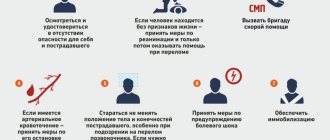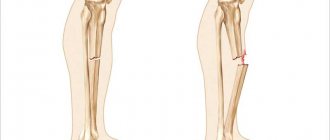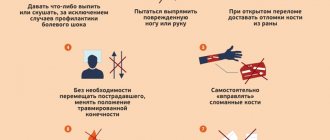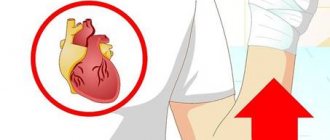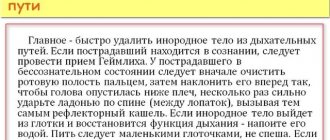Types of shock
| Hypovolemic | Cardiogenic | Redistributive |
1. Blood loss:
2. Plasma loss:
3. Fluid loss:
| 1. Acute myocardial infarction (true cardiogenic). 2. Heart rhythm disturbances. 3. Pulmonary embolism (obstructive) 4. Cardiac tamponade | 1. Anaphylactic shock. 2. Septic shock (infectious-toxic). 3. Spinal shock (neurogenic) |
Main symptoms of shock:
- Cold, pale, damp skin.
- The “white spot” symptom is a slow filling of the skin capillaries after they are compressed (more than 2 seconds).
- Tachycardia.
- At first there is excitement, then inhibition.
- Decrease in systolic blood pressure less than 100 mm Hg.
- Decrease in pulse pressure less than 20 mm Hg.
- Decreased diuresis (oligo- or anuria).
Shock of any etiology is characterized by a phased development of peripheral circulatory disorders, however, the sequence of phase development is not always traceable. The treatment provided depends on the type of shock and the underlying cause.
In childhood, emergency care by a pediatrician is most often required for redistribution shock (infectious-toxic and anaphylactic).
Infectious-toxic shock
Infectious-toxic shock can occur in patients with meningococcal infection, especially often in the fulminant form of meningococcemia, staphylococcal and fungal sepsis, as well as in other acute infectious diseases with a severe course (diphtheria, scarlet fever and others).
Stages of infectious-toxic shock:
I (compensated) - hyperthermia, consciousness is preserved, the child may be agitated or restless, tachypnea, tachycardia, normal blood pressure.
II (subcompensated) - low-grade or normal body temperature, lethargy, stupor, lethargy, pronounced tachypnea and tachycardia, systolic blood pressure decreases by 30-50% of the initial age level, positive “white spot” symptom, decreased urine output to 25-10 ml /hour.
III (decompensated) – hypothermia, lethargy up to prostration, sharp tachycardia, sharp tachypnea, widespread cyanosis of the skin and mucous membranes, oliguria less than 10 ml/hour or anuria, blood pressure drop to critical, pulse is determined only in large vessels, positive “white spot” symptom " Subsequently, the clinic of the agonal state develops.
At the prehospital stage, the volume of emergency care for patients with ITS depends on the cause and stage of shock and is aimed at combating life-threatening syndromes - hyperthermic, convulsive, etc.
Urgent Care:
- for hyperthermia - administer a 50% solution of metamizole (analgin) in combination with a 1% solution of diphenhydramine (diphenhydramine) in a dose of 0.1-0.15 ml per year of life intramuscularly;
- in case of severe psychomotor agitation and convulsions, administer a 0.5% diazepam solution in a single dose of 0.1 ml/kg body weight (no more than 2 ml per administration) intravenously or intramuscularly;
- for ITS that developed against the background of meningococcemia, administer chloramphenicol (chloramphenicol succinate) at a dose of 30 mg/kg intramuscularly;
- for cerebral edema - administer a 1% solution of furosemide (Lasix) at a rate of 1-2 mg/kg intramuscularly (only with systolic blood pressure not lower than 100 mm Hg) or 25% solution of magnesium sulfate 1.0 ml for a year of life;
- for ITS stage I - administer prednisolone at a rate of 3-5 mg/kg intramuscularly;
- for ITS stage II:
- oxygen therapy;
- provide access to the vein;
- administer prednisolone 5-10 mg/kg body weight intravenously, if there is no effect and it is impossible to transport the patient within 30-40 minutes. - repeated administration of prednisolone in the same doses;
- intravenous administration of crystalloid (0.9% sodium chloride solution) and colloid solutions (reopolyglucin, polyglucin, 5% albumin) until blood pressure normalizes (up to 15 ml/kg body weight);
- for ITS stage III:
- oxygen therapy;
- provide access to a vein (preferably two);
- administer prednisolone 10 mg/kg body weight intravenously, if there is no effect, repeat administration in the same doses after 30-40 minutes;
- inject a 0.9% sodium chloride solution intravenously in a single dose of 20 ml/kg until a distinct pulse appears on the radial artery; if there is no effect, repeat the bolus injection at the same dose after 15-20 minutes.
Hospitalization - in the intensive care unit of the hospital.
Resuscitation measures
In case of loss of consciousness and respiratory arrest, urgent resuscitation measures must be performed. Artificial respiration is performed mouth to mouth. To do this, the person’s head needs to be tilted back, placing a cushion made of a towel or any other fabric under the neck. The person performing resuscitation must inhale air, cover the victim's nose with his fingers, and exhale air through the victim's mouth. You need to take up to 12 breaths in one minute.
During the provision of first aid, it is necessary to monitor the patient’s pulse. If a person loses consciousness and heartbeats cannot be heard, chest compressions must be performed. To perform it, the patient is placed on his back, the surface must be hard. The person performing the massage should position himself to the side of the patient. The heels of your palms should press down on the chest area in the middle. Pushes are performed with straight arms; there is no need to bend them. The frequency of pressing is at least 60 shocks per minute. If an elderly person is being resuscitated, the number of pushes per minute is up to 50, for children - 120 pushes. Important! When performing artificial respiration and chest compressions simultaneously, you should alternate 2 breaths with 30 shocks.
Meningococcal infection
Meningococcemia is one of the forms of generalized meningococcal infection, characterized by an acute onset with a rise in body temperature to febrile levels, general intoxication, hemorrhagic skin rashes, and the development of infectious-toxic shock.
Clinical manifestations of meningococcal infection:
- Often acute onset or sharp deterioration due to nasopharyngitis.
- High, persistent fever with signs of impaired peripheral circulation. Early signs of fulminant toxic progression of meningococcal infection may be a “two-humped” nature of the temperature curve - the first increase in body temperature to 38.5ºC is reduced with the help of antipyretics, the second (after 9-18 hours) - to 39.5-40ºC without the effect of antipyretics.
- Hemorrhagic rash that appears a few hours or 1-2 days after the onset of fever. The typical localization of the rash is the outer surface of the thighs and legs, buttocks, feet, hands, and lower abdomen. Often a hemorrhagic rash is preceded or combined with a polymorphic roseolous or roseolous papular rash with the same localization, less often on the face.
- General cerebral symptoms: intense headache, “cerebral vomiting”, possible disturbances of consciousness, delirium, hallucinations, psychomotor agitation, convulsions.
- Meningeal syndrome. It usually appears later, against the background of advanced symptoms of meningococcemia.
Threatening syndromes in generalized forms of meningococcal infection are:
- infectious-toxic shock develops during the hyperacute course of meningococcemia. As a rule, symptoms of shock occur simultaneously or after the appearance of a hemorrhagic rash. However, ITS can occur without a rash, so all children with infectious toxicosis should have their blood pressure measured;
- cerebral edema with brainstem dislocation. It manifests itself as impaired consciousness, hyperthermia, severe meningeal symptoms (sometimes their absence in the terminal stage of the disease), convulsive syndrome and unusual changes in hemodynamics in the form of relative bradycardia and a tendency to increase blood pressure. In the terminal stage of cerebral edema there is absolute bradycardia and respiratory arrhythmia.
Urgent Care:
- Ensure patency of the upper respiratory tract, oxygen therapy.
- Administer chloramphenicol (chloramphenicol succinate) at a dose of 25-30 mg/kg intramuscularly.
- Intravenous (if not possible, intramuscular) administration of glucocorticoids in terms of prednisolone 5-10 mg/kg or dexamethasone 0.6-0.7 mg/kg body weight; if there is no effect and it is impossible to transport the patient, it is necessary to re-introduce hormones in the same doses (for ITS stage III, the dose of corticosteroids can be increased 2-5 times).
- Introduce a 50% solution of metamizole (analgin) 0.1 ml/year of life intramuscularly + 1% solution of diphenhydramine (diphenhydramine) at a dose of 0.1-0.15 ml per year of life intramuscularly (or 2% solution Suprastin solution – 2 mg/kg intramuscularly) + 2% papaverine solution 0.1 ml/year of life).
- For agitation, convulsive syndrome - 0.5% diazepam solution in a single dose of 0.1 ml/kg body weight (no more than 2 ml per administration) intravenously or intramuscularly, for intractable convulsions again in the same dose .
- In case of severe meningeal syndrome - intramuscular administration of a 1% furosemide solution at the rate of 1-2 mg/kg intramuscularly or 25% magnesium sulfate solution 1.0 ml/year of life intramuscularly.
Call the resuscitation team for yourself!!! Hospitalization in the intensive care unit of the nearest hospital. If meningococcal infection is suspected, hospitalization is indicated .
Intestinal toxicosis with exicosis is a pathological condition that is a complication of acute intestinal infections (AI) due to exposure to toxic products and significant fluid losses on the body, which leads to disruption of hemodynamics, water-electrolyte metabolism, acid-base reserve, and the development of secondary endogenous intoxication.
In the pathogenesis of toxicosis with exicosis, the leading role is played by dehydration, which leads to a deficiency in the volume of extra- (and in severe cases, intra-) cellular fluid and the volume of circulating blood. The degree of exicosis (dehydration) determines the choice of therapeutic tactics and affects the prognosis.
Severity of dehydration
| Signs | Degrees of dehydration | |||
| I degree | II degree* | III degree | ||
| Underweight | Up to 5% | 6-9 % | More than 10% | |
| BCC deficiency | More than 10% | 11-20 % | More than 20% | |
| General state | good | Excitation | Lethargic, lethargic, unconscious | |
| Chair | Infrequent (4-6 times a day) | Up to 10 times a day | Frequent (more than 10 times a day), watery | |
| Vomit | One-time | Repeated (3-4 times a day) | Multiple | |
| Thirst | Moderate | Sharply expressed | Refusal to drink | |
| Skin fold | Spreads out quickly | Unfolds slowly (≤2 sec) | Unfolds very slowly (>2 sec) | |
| Mucous membranes | Moist or slightly dry | Dry | Very dry, bright | |
| Cyanosis | ||||
| Eyeballs | Without features | Soft | They're sinking | |
| Voice | Without features | Weakened | Aphonia | |
| Heart sounds | Loud | Slightly muted | Deaf | |
| Heart rate | Norm | Moderate tachycardia | Severe tachycardia | |
| Diuresis | Saved | Reduced | Significantly reduced | |
| Blood plasma electrolytes | Norm | Hypokalemia | Hypokalemia | |
| CBS | Norm | Compensated acidosis | Decompensated acidosis | |
| Rehydration method | Oral | Parenteral | ||
- II degree of exicosis is divided into IIA and IIB (with loss of body weight 6-7% and 8-9%, respectively).
Measures for dehydration
When starting to rehydrate children with exicosis, it is necessary to determine which route (orally and/or parenterally) and what volume of fluid should be administered to the child, at what speed to administer, and what solutions to use. Oral rehydration is carried out for exicosis of I, IIA degrees, parenteral - for exicosis of IIB and III degrees.
Outpatient treatment is possible (in the absence of other contraindications, see below) for grade I exicosis with oral rehydration.
Oral rehydration therapy
Indications: exicosis I, IIA degrees.
- The necessary solutions are glucose-salt (rehydron, oralit, gastrolit, glucosalan). In children under 3 years of age, it is advisable to combine glucose-saline solutions with salt-free solutions (tea, water, rice water, etc.) in a ratio of 1:1 - for severe watery diarrhea, 2:1 - for loss of fluid mainly through vomiting, 1: 2 – with loss of fluid with perspiration. The administration of saline and salt-free solutions alternates.
The amount of liquid for each hour of administration is divided into ½ teaspoon - 1 tablespoon (depending on age) every 5-10 minutes. If there is vomiting, rehydration does not stop, but is interrupted for 5-10 minutes and then continues again.
Features of the introduction of solutions at the 1st stage (the first 6 hours from the start of treatment):
- for grade I dehydration: 50 ml/kg for 6 hours. + 10 ml/kg b.w. after each loose stool or vomiting;
- for degree IIA dehydration: 80 ml/kg for 6 hours + 10 ml/kg b.w. after each loose stool or vomiting.
At the 2nd stage, maintenance therapy is carried out in the amount of ongoing fluid losses administered at this stage (80-100 ml/kg per day until the loss stops).
First aid courses
Shock (also known as circulatory shock) is a severe, life-threatening condition in which blood does not circulate properly throughout the body or is not used properly by cells. In this situation, cells and tissue cannot work as well as they should, and vital organs such as the heart and brain can become damaged or even die. As a result, promptly recognizing and treating symptoms of shock can make a significant difference in the outcome of the condition. This is an important part of first aid for shock and in this article we will look at what causes shock and its symptoms, signs of shock, first aid for shock.
Note: shock should not be confused with the more common term referring to the mental state of shock that may occur during or after an accident, but which is mental in its effects.
What are the causes of shock?
There are several different types of shock that are associated with a variety of causes. Four main ones:
- Cardiogenic shock. Directly related to heart problems and the inability of the heart to pump blood properly, it is the most common type of shock when a person suffers from heart failure.
- Hypovolemic shock. Caused by a decrease in blood volume in the human body and is usually the result of severe bleeding from either external or internal sources. This shock can also be caused by massive fluid loss, which can result from severe cases of diarrhea or vomiting.
- Obstructive shock. Similar to cardiogenic shock, this type of shock occurs when an obstruction outside the heart prevents blood from circulating properly.
- Distribution shock. It covers various types of shock that result from insufficient oxygen utilization by the body's cells. The most common form is septic shock, caused by spreading infection. Another form is anaphylactic shock, which occurs when a person has a severe allergic reaction to an allergen, such as medication or venom from a bee or other venomous insect sting.
Shock and its symptoms
To determine if a person is suffering from shock, you should observe the following symptoms:
- Pale, cold and/or clammy skin
- Fast and shallow breathing
- Fast and weak pulse
- Confusion
- Thirst
- Low blood pressure
- Slow capillary refill
- Excessive yawning (air hunger)
- Lack of response to activation or unconsciousness
Not all signs of shock will be present in all patients, but these are generally the most common. If you have any doubts, call 103 or 112 .
First aid for shock
It is very important to note that shock is usually not reversible in a first aid situation, and your job is to manage the symptoms of this condition until emergency medical help arrives. If possible, you should also provide assistance to contain any injuries or conditions that may be causing shock (eg, trying to stop bleeding). The sequence in which first aid is provided for shock:
- Step 1: If possible, position the victim horizontally as this will help maintain blood circulation throughout the body.
- Step 2: Try to elevate the victim's legs about 30 cm to divert blood flow to more vital organs.
- Step 3: Call an ambulance (tel. 103 or 112) and explain the situation to the operator. If possible, explain why the person is suffering from shock.
- Step 4: Try loosening any clothing, especially around the victim's neck, chest, and waist to stimulate circulation.
- Step 5: Try to keep the victim calm, as stress can make the situation worse. Talk, comfort and reassure him. You should also keep him as warm and comfortable as possible. To do this, you can use coats, blankets or other warm and soft clothing.
- Step 6: Monitor the person’s breathing and pulse, his well-being and reactions.
- Step 7: If the victim loses consciousness, vomits, or is choking, place him in the Safety Side Position or turn his head to the side to prevent him from choking.
- Step 8: Finally, you may need to perform CPR until emergency medical help arrives.
Our first aid courses provide hands-on first aid for shock.
You can ask questions about the content and organization of courses by email or by phone

